Palačinke are lacy, delicate, crêpe-like pancakes loved across the Balkans. You can enjoy them for breakfast or dinner and fill them with sweet or savory flavors—they're irresistible in every way. Here's how to make the laciest, tastiest ones. Shall we?
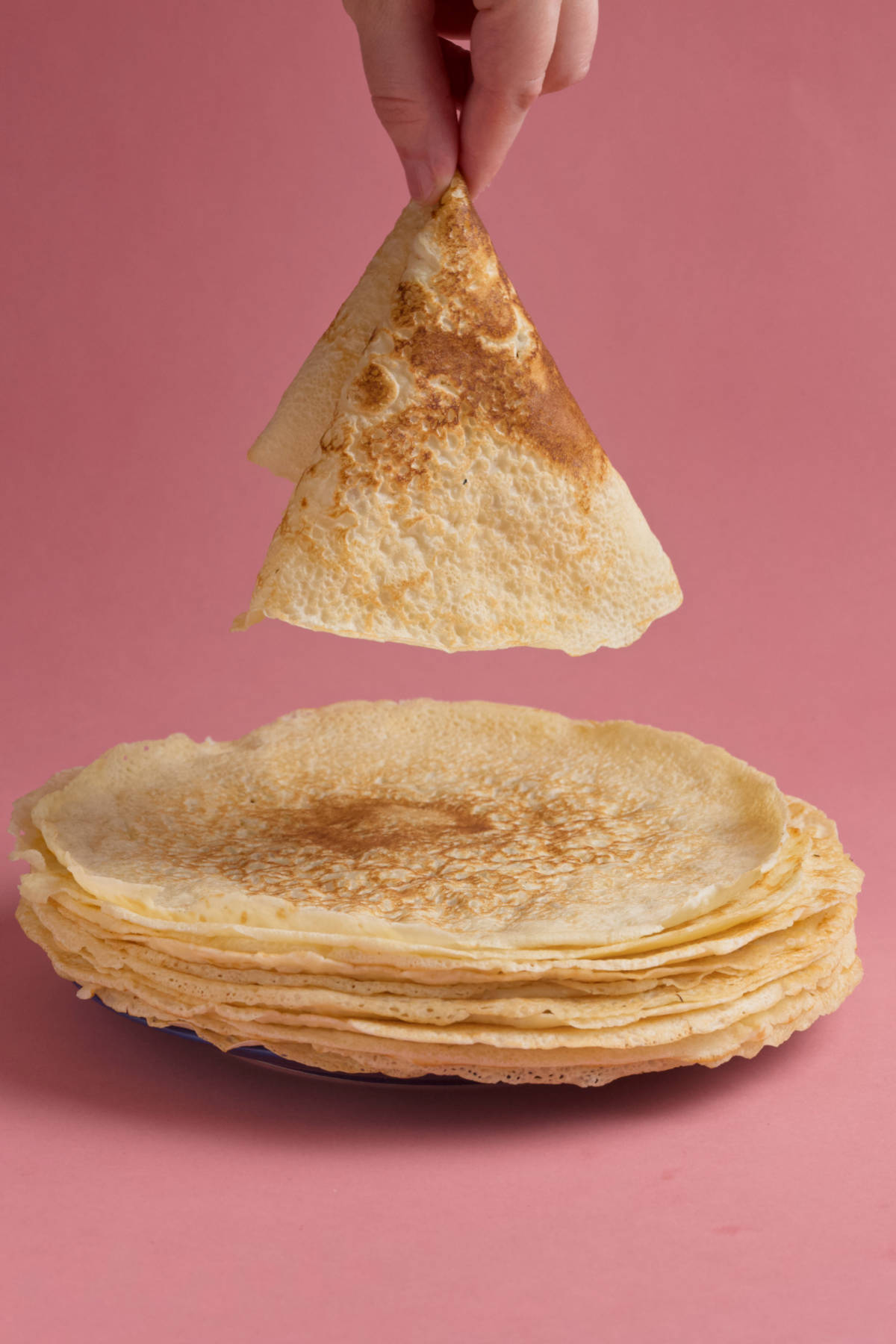
Jump to:
Background
Palačinke (sing. palačinka) - the type of crêpes made in the Balkans and Eastern Europe - are a kitchen staple! (And everyone's favorite dish!)
Thin, delicate, and lacy, palačinke are the perfect canvas for any type of filling: savory or sweet. They're great for breakfast, dessert, or a main course.
(Anecdotal evidence shows that in the Balkans, every family has a designated palačinke chef. 😁 This is the person whose palačinke are considered the best, and who takes this role quite seriously.)
Palačinke are old as time. The earliest ones originated in the Greco-Roman period when their basic recipe called for a simple batter made from water and flour.
Since then, the recipe was upgraded to include a couple more everyday ingredients. Today we bring you a great, easy palačinke recipe you'll get a hang of immediately.
Why You'll Love This Recipe
Simple Ingredients! Think basic pantry staples: flour, water, milk, mineral water, eggs, sugar, salt, and oil! Missing a few? As long as you have flour and water you're set! Accessible and straightforward is what this recipe is all about!
Versatile Fillings! You can fill palačinke with anything. (And we mean anything!) Jams, preserves, Nutella, ground nuts, melted chocolate, whipping cream, mushrooms, mayo, ham, ajvar, cheese, tartar sauce, satarash, vegetables, and more!
Constant Improvement! We continually improve our palačinke to bring you the laciest and tastiest crepes ever. Even if we change a few small things in the future, we promise this recipe will always produce amazing ones.
Ingredients
Let’s take a look at what you’ll need to make Balkan-style crépes palačinke.
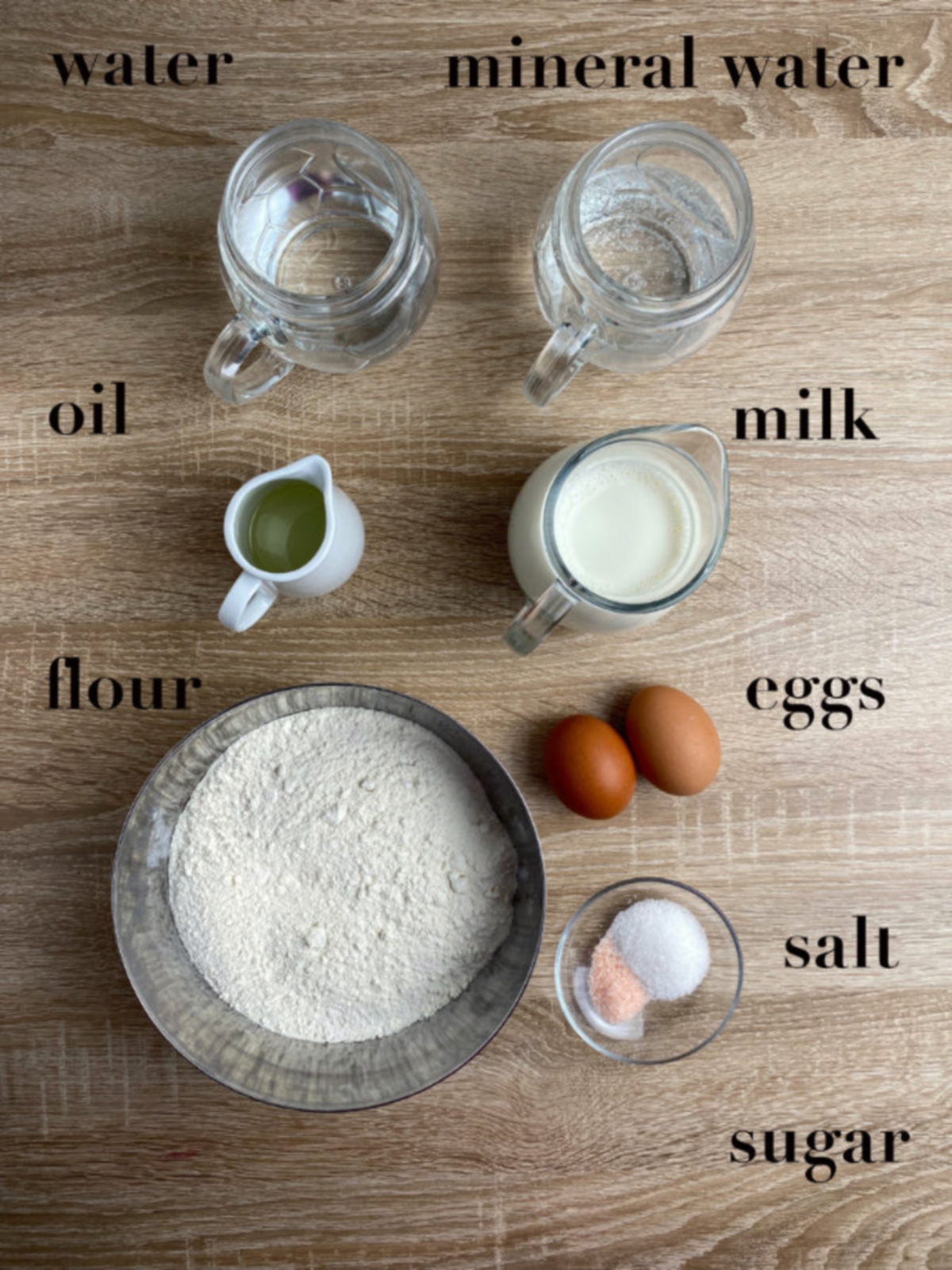
- Flour. Regular white flour. Swap a portion of flour with ground coconut flour for a more exotic taste.
- Water. Tap or bottle work fine.
- Mineral Water. Helps create a fluffier texture. Substitute with regular water.
- Milk. Regular milk works best. Substitute with soy or almond milk.
- Eggs.
- Salt. Regular table salt or Himalayan salt works best. Avoid coarse-grained salt.
- Sugar. Regular granulated sugar. Substitute with powdered or brown sugar.
- Oil (for greasing the pan). Most vegetable oils work well. Substitute with avocado oil, or coconut oil (melt beforehand). Avoid olive oil for crepes.
- (Optional) Vanilla.
- (Optional) A pinch of baking powder instead of mineral water helps create a fluffy texture.
Instructions
Here are easy instructions for making our Balkan-style crêpes.
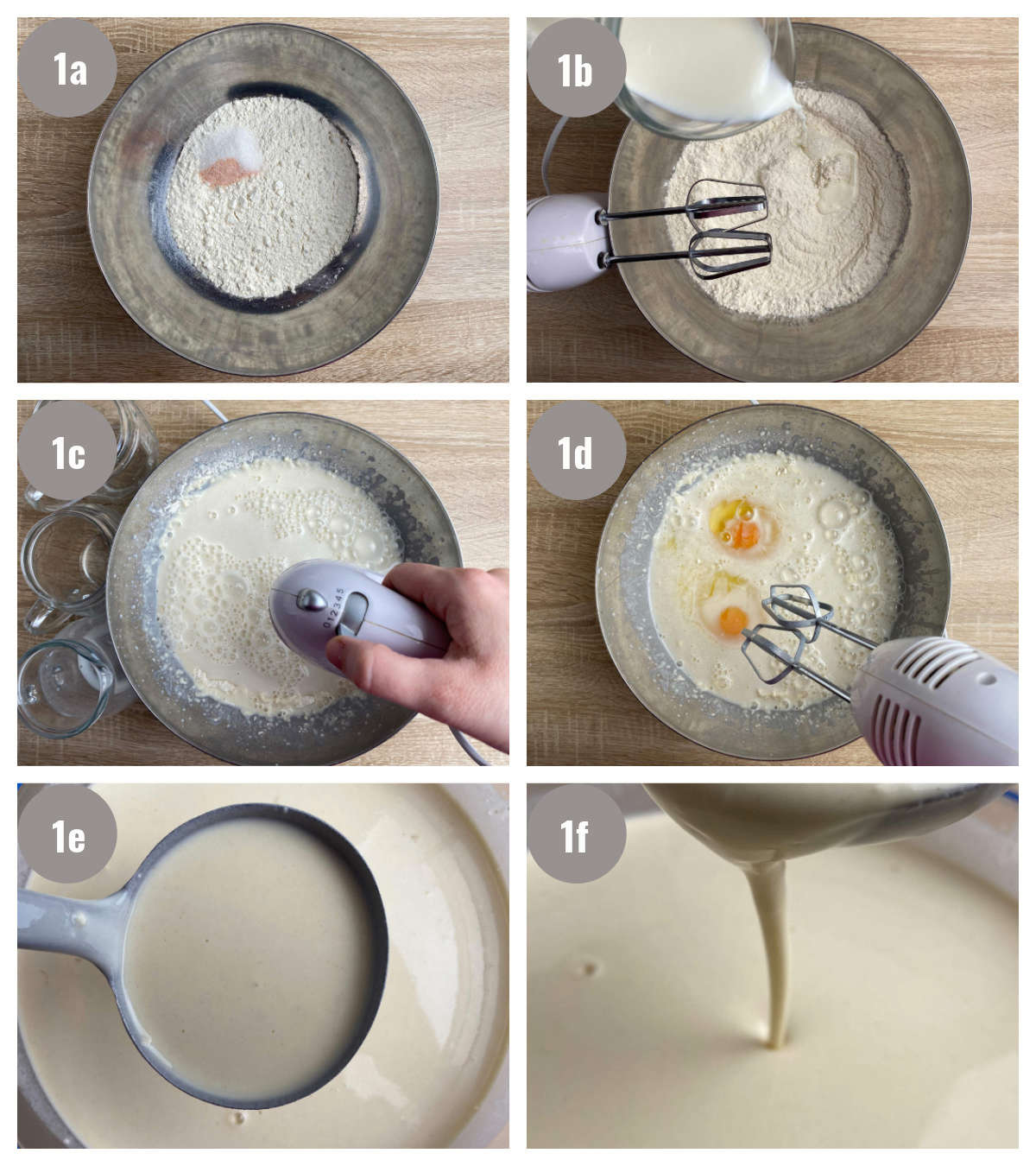
Step 1. In a large bowl, whisk together flour, sugar, and salt. Gradually add milk, water, mineral water, and eggs. Whisk (or mix with a mixer) until smooth.
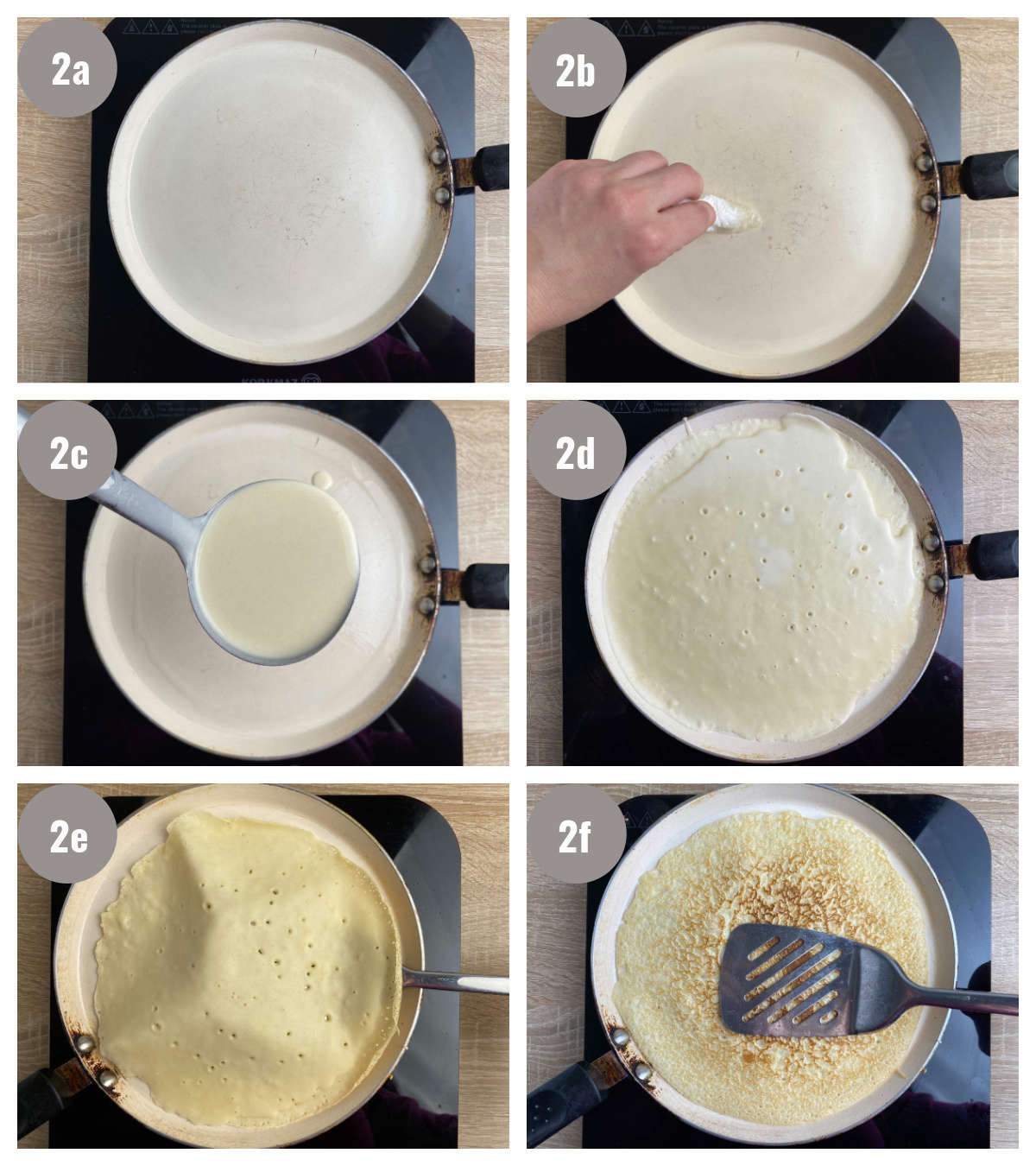
Step 2. Heat a pan, and grease it with an oiled paper towel. Pour batter and swirl the pan to coat evenly. Cook on both sides until golden.
Step 3. (Not pictured.) Transfer cooked palačinke to a plate and cover with a kitchen towel. Stack them and let them rest until all are done.
Step 4. (Not pictured.) Fill with sweet or savory ingredients, then roll or fold. Enjoy!
Handling
Here are a few ideas for handling palačinke.
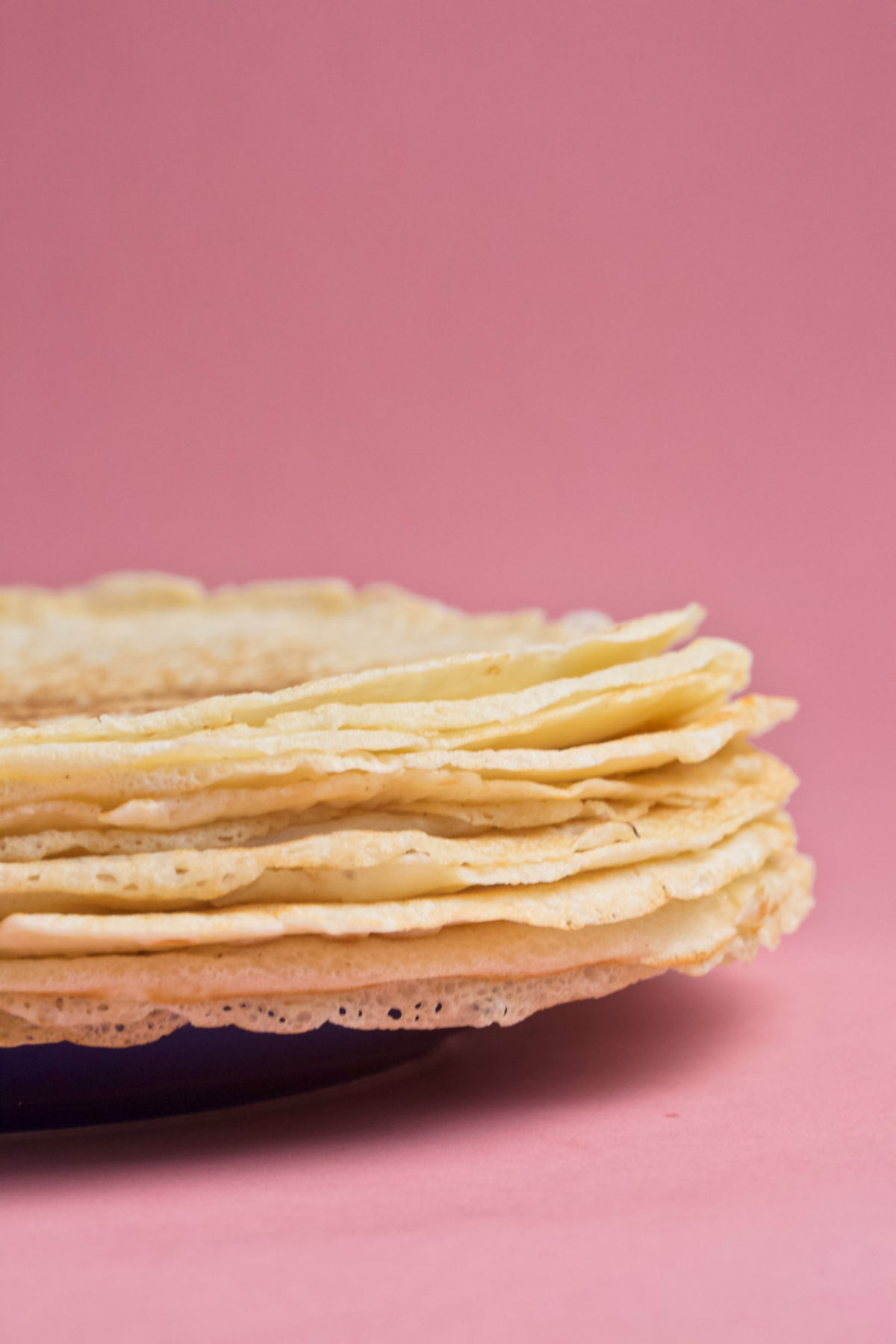
Serving: Fill crepes up with a filling of choice (take a look at the fillings suggestion section below). Serve warm or cold.
Storage: Store leftover crepes in an airtight container in a cooler kitchen for up to a day, or in the refrigerator for 1-2 days. (Note: while cooked palačinke can be stored outside in a cool place in an airtight container, unused batter should always be kept in the fridge!)
Tip: instead of keeping palačinke in the fridge, it's better to make as many as you'll eat in one sitting, and keep the batter in the fridge. This way you can have fresh ones each time. Reheated palačinke are at risk of being chewy and hard.
When ready, take the batter out, whisk it, and add a pinch of water to thin it out. The batter will keep in the fridge for up to 2 days.
One time we don't recommend not cooking palačinke right away is when you want to save time. For example, when you're making a more complex dish with multiple steps (breaded palačinke, etc.), it's best to make a batch of palačinke ahead of time.
Reheating: Reheat in a pan over low heat until warmed through, or using your preferred method.
Expert Tips
Here are a few tips that will take your palačinke to the next level.
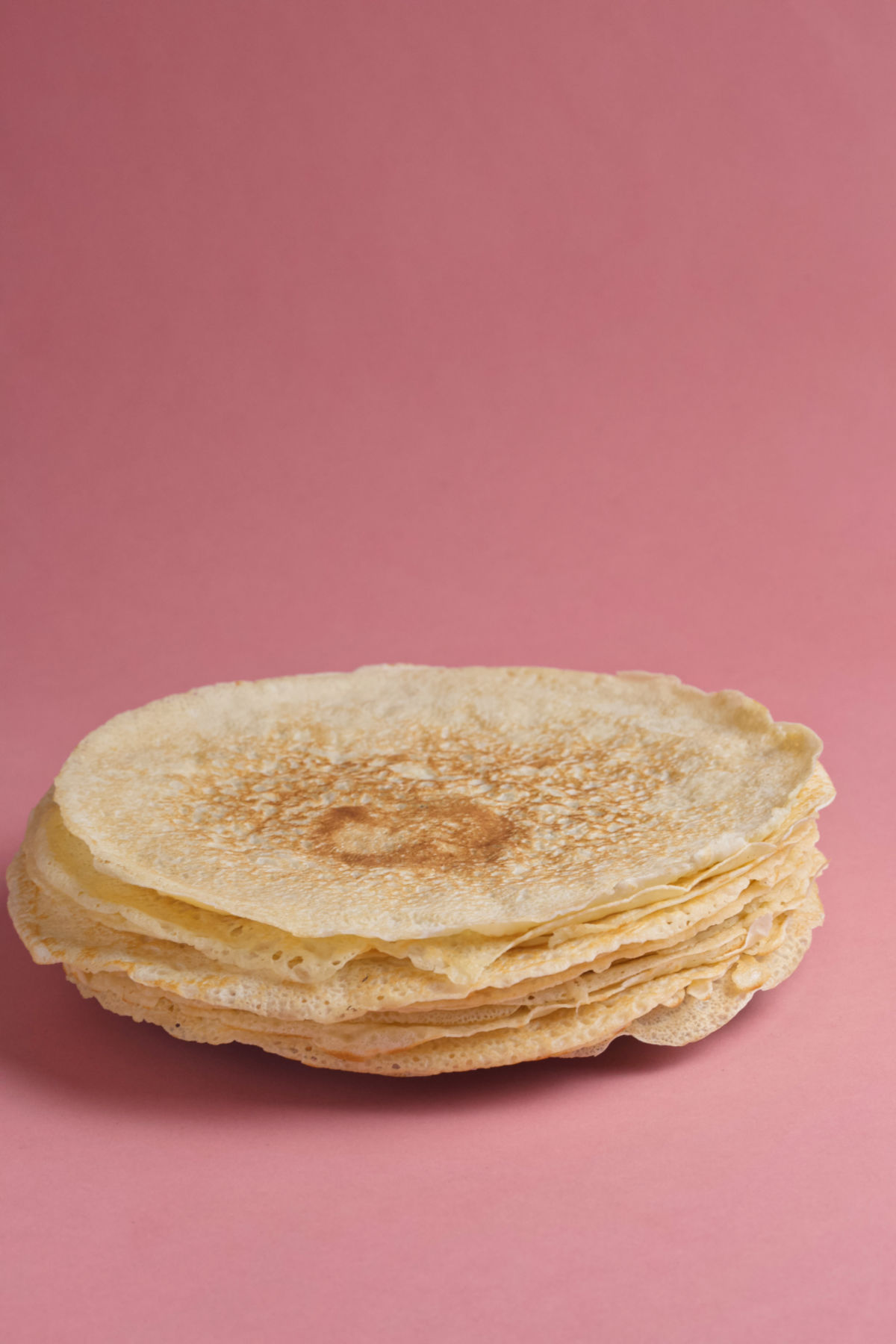
Oil. Heat the pan well before frying. Then dab it with an oiled paper towel. This is the optimal amount of oil for palačinke.
Volume. About a ladle, or ½ cup, is the perfect volume for a 9-inch (25cm) pan.
Perfect Pan. You don't need a crêpe pan to make crêpes or palačinke. A stainless steel skillet or a non-stick pan will do just fine. Avoid cast iron pans as they're heavy, and pans that have some sort of design on the bottom (this can cause the batter to stick).
(A fun story! Our mom had an old pan she used for palačinke for years. She finally disposed of it recently. Although we disagree, she swears her palačinke are nowhere near as good as they were when she used that pan.)
Water and Flour. Our brother - aka our family's designated palačinka chef - follows only one rule for perfect Balkan crêpes. Just keep adding a little bit of water or a little bit of flour until you reach the right consistency. Thick? Add a little bit of water. Thin? Add a little bit of flour.
Thickness. After you make a few rounds of these, you'll know how thick you like them. Look at the tip above to adjust consistency.
First Few Suck. The first one or two palačinke of the batch generally suck. They're too soft, or they rip easily, or they simply aren't what you expect. However, the more you make, the better they get. It could be that the pan gets the right hotness, or you simply get more experience. Either way, being patient pays off!
Don't Go. Watching palačinke fry takes an eternity. However, as soon as you step away, they burn. Keep at it and you'll be happy you waited!
Palačinke Filling Suggestions
If you are wondering what are popular palačinka fillings, here are some ideas.
Sweet
- Nutella or chocolate (melted, grated, chips, white, dark, milk, etc.)
- Jams and preserves (fig jam, orange jam, raspberry jam, rose hip jam, plum jam, etc.)
- Syrups and honey (maple, strawberry, etc.)
- Fruit (fresh, dried, or frozen)
- Ground nuts with a spoonful of sugar (walnuts, hazelnuts, almonds, coconuts, pistachios, peanuts, etc.)
- Ground biscuits or cookies (Oreos, chocolate chip, Plazma, etc.)
- Ice cream or whipped cream
- Candy (marshmallow)
- Cream (caramel, vanilla, etc.)
Savory
- Mushrooms
- Other vegetables (fresh, frozen, or cooked)
- Spinach
- Ham and Cheese (together or separately)
- Chicken or other poultry
- Nut butters (pistachio, almond, peanut, etc.)
- Meat (dried, cooked, smoked, etc.)
- Fish and seafood
- Sauces (tartar, marinara, etc.)
Recipe FAQs
Palačinke (sing. palačinka) are thin, delicate crêpes (they're essentially skinny pancakes) popular in the Balkans, Central and Eastern Europe. Tasty and versatile, palačinke can be consumed with sweet or savory fillings.
(Look at the section above for ideas!)
To prevent palačinke from sticking, first heat the pan well. Once hot, coat it with oil dabbed on a paper towel. This should coat the pan evenly, but lightly. Only then add the batter to the pan.
Furthermore, give palačinke plenty of time to fry (about 30-60 seconds on each side). If you try to flip them before they're cooked, they will stick to the pan. Simply wait for the edges to rise a little bit, and check that the crepe is moving by lightly shaking the pan from left to right.
Also, as you oil the pan again after each crepe, remove any crumbs.
Finally, remember that sometimes the first couple of crepes don't come out well. Simply continue the process. As you cook more of them, they'll come out better and better.
Yes. However, while palačinke can be made ahead and stored, they taste best when you make them just before serving them. It's better to store the batter in the fridge and make fresh ones each time you want them.
One time we do recommend making them ahead and storing them is to save time when you're making a more complex dish requiring lots of steps. (Think breaded palačinke with ham and cheese, etc.)
Store them in an airtight container in the fridge (or a cooler kitchen), for up to 2 days. Reheat using your preferred method.
Thoughts?
If you make today's palačinke or Balkan-style crêpes and like them, please consider leaving a ⭐️⭐️⭐️⭐️⭐️ (5-star) rating. This will help others find the recipe more easily!
You can also leave a comment, I read EVERY one! Finally, if IG is more your thing, consider tagging us @balkanlunchbox.
Prijatno, Dobar Tek, and Bon Appetit!
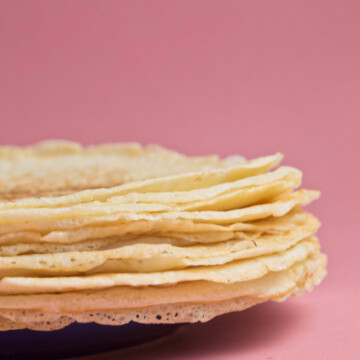
Palačinke - Balkan-style Crêpes
Equipment
- 1 9-inch (25 cm) flat pan crêpe pan is great but not necessary; a flat, non-stick pan, or a stainless steel skillet will do just fine; avoid heavy pans with designs on the bottom cast iron pans, and woks
- 1 ladle, or ½c measuring tool perfect volume for one palačinka
Ingredients
- 17-18 ounces white flour regular white flour; swap a portion of flour with ground coconut flour per taste
- ½ teaspoon salt avoid coarse salt
- 1 teaspoon granulated sugar substitute with powdered
- 17 ounces milk (a little more than 2 cups) regular milk, substitute with almond or soy
- 10 ounces water tap or bottle
- 8.5 ounces mineral water substitute with regular water
- 2 eggs
- oil for pan greasing, most oils work well, avoid olive oil and butter
- (Optional) vanilla half a teaspoon of liquid or powder
- (Optional) baking powder if not using mineral water half a teaspoon
- filling of choice, sweet or savory jam, preserve, Nutella, chocolate, whipped cream, nuts, candy, caramel, vegetables, sauces, meat, cheese, etc.
Instructions
Cooking Instructions
- In a large bowl, whisk together flour, sugar, and salt. Gradually add milk while whisking (or mixing with a hand mixer). Follow with water and mineral water, continuing to whisk until smooth. Now add the eggs and mix until fully incorporated. At the very end, use a spatula to scrape any flour from the sides of the bowl, and mix it in, to avoid potential crumbs. (If necessary, transfer the batter to another bowl through a strainer or colander.) The batter should be completely crumb-free and have the consistency between milk and heavy cream.
- If possible, rest the batter in the fridge for 30-60 minutes (or more). If the batter separates, whisk again before frying palačinke, adding a pinch of water if necessary.
- Heat a pan thoroughly over high heat. (However, if your stove runs hotter than most, you can cook them on medium, to medium-high heat. Adjust the temperature according to your stove.) Crunch up a paper towel, dip it in oil, and grease the pan lightly but thoroughly (watch your fingers!). (As you're using a small amount of oil on a very hot pan, there is no need to heat the oil further before adding the batter.)
- Using a ladle (or a ½ cup measuring tool), pour the batter into the pan. Swirl the pan around (it may take a couple of swirls). The batter should swirl 'lazily' until it is distributed evenly over the surface. Cook the first side for 30 seconds to 1 minute, or until the edges start to brown and lift slightly. Flip with a spatula and cook the other side for 30 seconds more.
- Palačinka Flipping Tip: If you're feeling confident, toss it in the air directly from the pan. Before flipping, ensure palačinka isn't stuck to the pan by gently shaking the pan from side to side.
- Transfer cooked palačinka onto a plate, and cover it with a kitchen towel. For the best taste, wait until all are done before adding fillings. Stacking them allows them to soften and deepen flavor.
- After one palačinka is done, coat the pan with oil again using the same paper towel method. While coating it, remove any crumbs that may have stayed from the previous crepe.
- Repeat the cooking process until you finish the batter, or cook enough palačinka for one sitting. This amount of batter will give you about 17-18 crêpes.
Handling Instructions
- Serving: Fill crêpes up with a filling of choice (take a look at the fillings suggestion section below). Serve warm or cold. Storage: Store leftover crêpes in an airtight container in a cooler kitchen for up to a day, or in the refrigerator for 1-2 days. (Note: unused batter should always be kept in the fridge!)Tip: instead of keeping palačinke in the fridge, it's better to make as many as you'll eat in one sitting, and keep the batter in the fridge. This way you can have fresh ones each time. Reheated palačinke are at risk of being chewy and hard.When ready, take the batter out, whisk it, and add a pinch of water to thin it out. The batter will keep in the fridge for up to 2 days.(However, one time we do recommend making them ahead is when you need to save time. For example, when you're making a more complex dish with multiple steps like breaded palačinke.)Reheating: Reheat in a pan over low heat until warmed through, or using your preferred method.
Video
Notes
- Nutritional Information
- Expert Tips For Perfect Palačinke

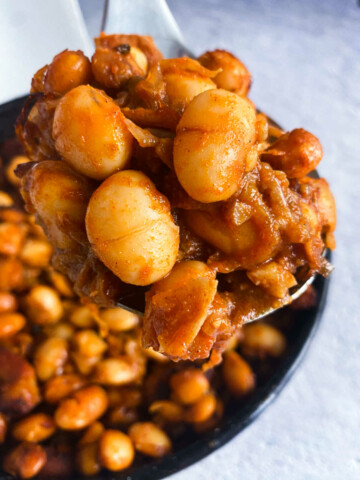
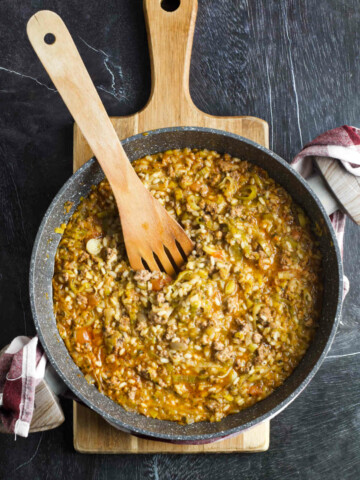
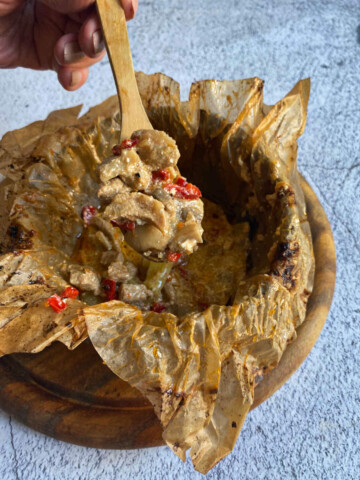
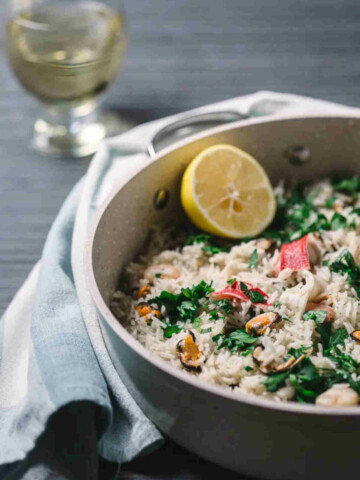
Ms Ilijeva says
My Macedonian Baba would make these into a sort of ‘pancake pie’ by stacking crepes similar to (if not the same as) these, brushed between with olive oil, crushed garlic and crumbled sirenje (white cheese)... once stacked, it would be warmed in the oven and cut into wedges or squares to serve.
I will have to try your recipe!
Fala
Aida says
That sounds divine! We'll have to try your baba's recipe. Do you know what kind of cheese she used? Softer cow cheese or more crumbly, harder ones?